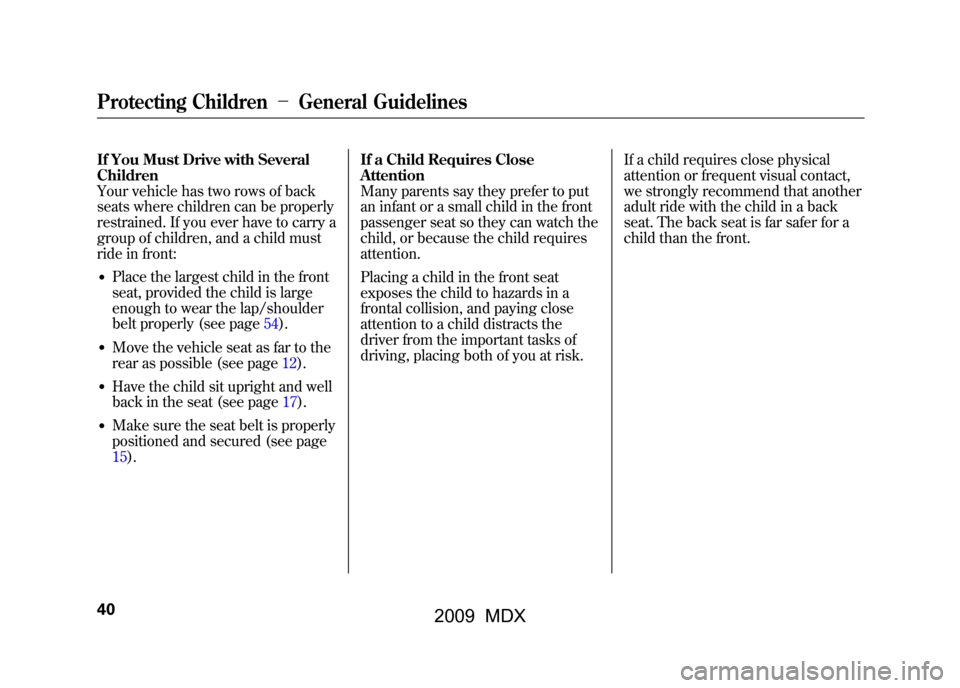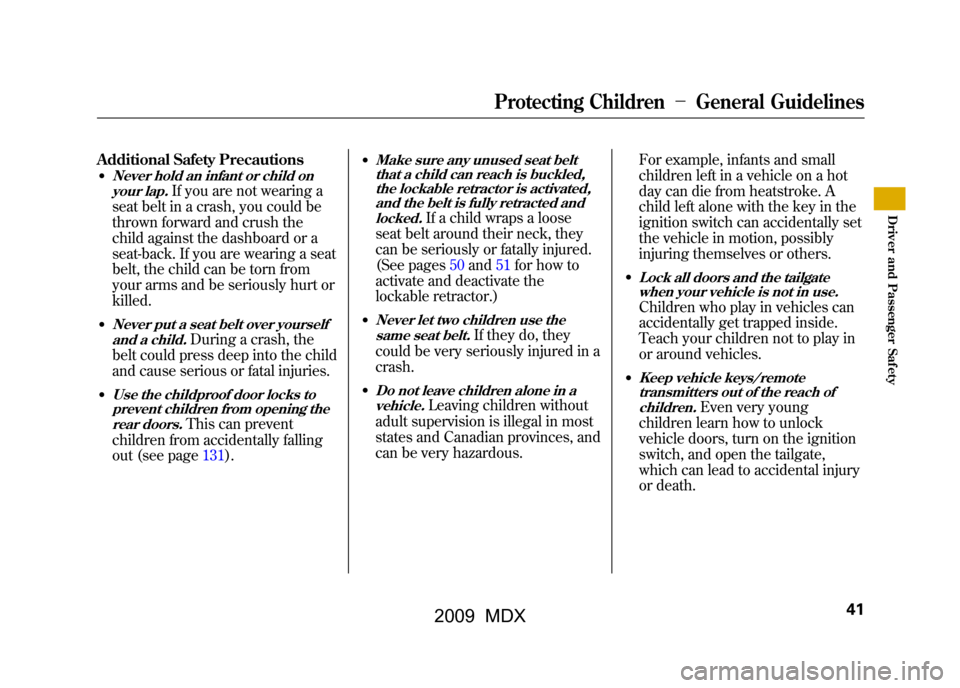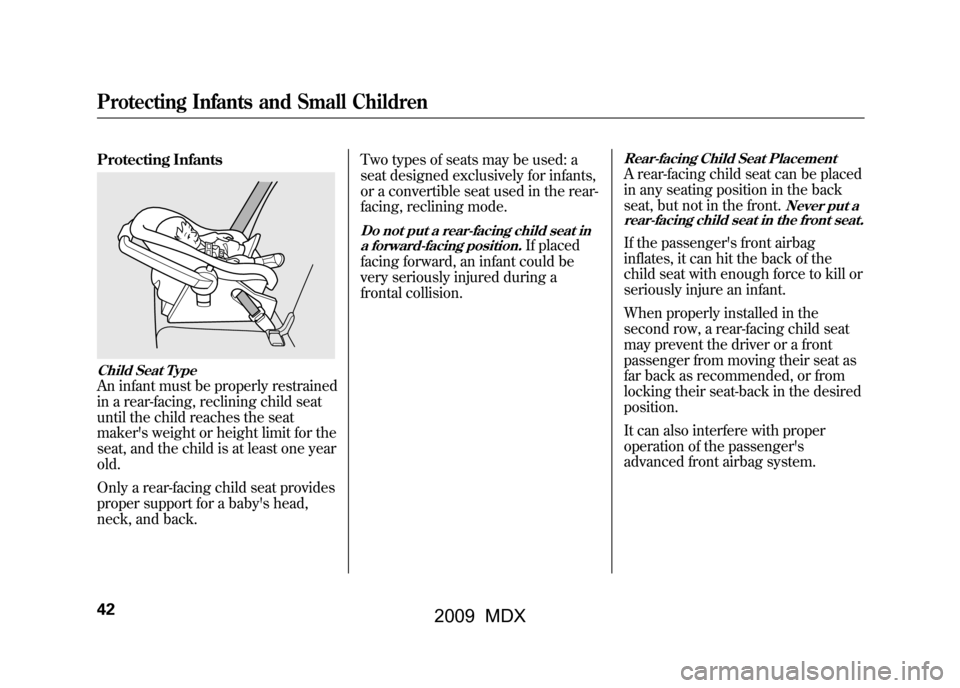Acura MDX 2009 Service Manual
Manufacturer: ACURA, Model Year: 2009, Model line: MDX, Model: Acura MDX 2009Pages: 489, PDF Size: 11.91 MB
Page 41 of 489

Children depend on adults to protect
them. However, despite their best
intentions, many adults do not know
how to
properly
protect child
passengers.
If you have children, or ever need to
drive with a child in your vehicle, be
sure to read this section. It begins
with important general guidelines,
then presents special information for
infants, small children, and larger
children. All Children Must Be Restrained
Each year, many children are injured
or killed in vehicle crashes because
they are either unrestrained or not
properly restrained. In fact, vehicle
accidents are the number one cause
of the death of children age 12 and
under.
To reduce the number of child
deaths and injuries, every state and
Canadian province requires that
infants and children be properly
restrained when they ride in a
vehicle.
Infants and small children must be
restrained in an approved child seatthat is properly secured to the vehicle(see pages 42- 53).
Children who are unrestrained
or improperly restrained can be
seriously injured or killed in a
crash.
Any child too small for a seat
belt should be properly
restrained in a child seat. A
larger child should be properly
restrained with a seat belt and
use a booster seat if necessary.
Larger children must be restrained
with a lap/shoulder belt and ride on abooster seat until the seat belt fits
them properly
(see pages 54-57).
Protecting Children -General Guidelines
37
Driver and Passenger Saf et y
08/06/06 16:58:07 09 ACURA MDX MMC North America Owner's M 50 31STX620 enu
2009 MDX
Page 42 of 489

All Children Should Sit in a Back
Seat
According to accident statistics,
children of all ages and sizes are
safer when they are restrained in a
back seat.
The National Highway Traffic Safety
Administration and Transport
Canada recommend that all children
aged 12 and under be properly
restrained in a back seat. Some
states have laws restricting where
children may ride.
Children who ride in the back are
less likely to be injured by striking
interior vehicle parts during a
collision or hard braking. Also,
children cannot be injured by an
inflating front airbag when they ride
in the back.The Passenger's Front Airbag Can
Pose Serious Risks
Front airbags have been designed to
help protect adults in a moderate to
severe frontal collision. To do this,
the passenger's front airbag is quite
large, and it can inflate with enough
force to cause very serious injuries.
Even though your vehicle has an
advanced front airbag system that
automatically turns the passenger's
front airbag off (see page34),please
follow these guidelines:
Infants
Never put a rear-facing child seat inthe front seat of a vehicle equipped
with a passenger's front airbag.
If the
airbag inflates, it can hit the back of
the child seat with enough force to
kill or very seriously injure an infant.
Small Children
Placing a forward-facing child seat inthe front seat of a vehicle equipped
with a passenger's front airbag can be
hazardous.
If the vehicle seat is too
far forward, or the child's head is
thrown forward during a collision, an
inflating front airbag can strike the
child with enough force to kill or
very seriously injure a small child.
Larger Children
Children who have outgrown childseats are also at risk of being injuredor killed by an inflating passenger's
front airbag.
Whenever possible,
larger children should sit in the back
seat, on a booster seat if needed, and
be properly restrained with a seat
belt. (See page54for important
information about protecting larger
children.)
Protecting Children -General Guidelines3808/06/06 16:58:07 09 ACURA MDX MMC North America Owner's M 50 31STX620 enu
2009 MDX
Page 43 of 489

To remind you of the passenger's
front airbag hazards, and that
children must be properly restrained
in a back seat, your vehicle has
warning labels on the dashboard
(U.S. models) and on the front visors.
Please read and follow the
instructions on these labels.
U.S. ModelsSUN VISORSDASHBOARDCanadian ModelsSUN VISORS
CONTINUED
Protecting Children
-General Guidelines
39
Driver and Passenger Saf et y
08/06/06 16:58:07 09 ACURA MDX MMC North America Owner's M 50 31STX620 enu
2009 MDX
Page 44 of 489

If You Must Drive with Several
Children
Your vehicle has two rows of back
seats where children can be properly
restrained. If you ever have to carry a
group of children, and a child must
ride in front:●Place the largest child in the front
seat, provided the child is large
enough to wear the lap/shoulder
belt properly (see page54).●Move the vehicle seat as far to the
rear as possible (see page12).●Have the child sit upright and well
back in the seat (see page17).●Make sure the seat belt is properly
positioned and secured (see page
15).If a Child Requires Close
Attention
Many parents say they prefer to put
an infant or a small child in the front
passenger seat so they can watch the
child, or because the child requires
attention.
Placing a child in the front seat
exposes the child to hazards in a
frontal collision, and paying close
attention to a child distracts the
driver from the important tasks of
driving, placing both of you at risk.
If a child requires close physical
attention or frequent visual contact,
we strongly recommend that another
adult ride with the child in a back
seat. The back seat is far safer for a
child than the front.Protecting Children
-General Guidelines4008/06/06 16:58:07 09 ACURA MDX MMC North America Owner's M 50 31STX620 enu
2009 MDX
Page 45 of 489

Additional Safety Precautions●Never hold an infant or child onyour lap.
If you are not wearing a
seat belt in a crash, you could be
thrown forward and crush the
child against the dashboard or a
seat-back. If you are wearing a seat
belt, the child can be torn from
your arms and be seriously hurt or
killed.
●Never put a seat belt over yourself
and a child.
During a crash, the
belt could press deep into the child
and cause serious or fatal injuries.
●Use the childproof door locks to prevent children from opening the
rear doors.
This can prevent
children from accidentally falling
out (see page131).
●Make sure any unused seat belt that a child can reach is buckled,the lockable retractor is activated,
and the belt is fully retracted and
locked.
If a child wraps a loose
seat belt around their neck, they
can be seriously or fatally injured.
(See pages50and51for how to
activate and deactivate the
lockable retractor.)
●Never let two children use the
same seat belt.
If they do, they
could be very seriously injured in a
crash.
●Do not leave children alone in a
vehicle.
Leaving children without
adult supervision is illegal in most
states and Canadian provinces, and
can be very hazardous. For example, infants and small
children left in a vehicle on a hot
day can die from heatstroke. A
child left alone with the key in the
ignition switch can accidentally set
the vehicle in motion, possibly
injuring themselves or others.
●Lock all doors and the tailgate
when your vehicle is not in use.Children who play in vehicles can
accidentally get trapped inside.
Teach your children not to play in
or around vehicles.●Keep vehicle keys/remotetransmitters out of the reach of
children.
Even very young
children learn how to unlock
vehicle doors, turn on the ignition
switch, and open the tailgate,
which can lead to accidental injury
or death.
Protecting Children -General Guidelines
41
Driver and Passenger Saf et y
08/06/06 16:58:07 09 ACURA MDX MMC North America Owner's M 50 31STX620 enu
2009 MDX
Page 46 of 489

Protecting InfantsChild Seat TypeAn infant must be properly restrained
in a rear-facing, reclining child seat
until the child reaches the seat
maker's weight or height limit for the
seat, and the child is at least one year
old.
Only a rear-facing child seat provides
proper support for a baby's head,
neck, and back.Two types of seats may be used: a
seat designed exclusively for infants,
or a convertible seat used in the rear-
facing, reclining mode.
Do not put a rear-facing child seat in
a forward-facing position.
If placed
facing forward, an infant could be
very seriously injured during a
frontal collision.
Rear-facing Child Seat PlacementA rear-facing child seat can be placed
in any seating position in the back
seat, but not in the front.
Never put a
rear-facing child seat in the front seat.
If the passenger's front airbag
inflates, it can hit the back of the
child seat with enough force to kill or
seriously injure an infant.
When properly installed in the
second row, a rear-facing child seat
may prevent the driver or a front
passenger from moving their seat as
far back as recommended, or from
locking their seat-back in the desired
position.
It can also interfere with proper
operation of the passenger's
advanced front airbag system.
Protecting Infants and Small Children4208/06/06 16:58:07 09 ACURA MDX MMC North America Owner's M 50 31STX620 enu
2009 MDX
Page 47 of 489

In any of these situations, we
strongly recommend that you install
the child seat directly behind the
front passenger's seat, move the seat
as far forward as needed, and leave it
unoccupied. Or, you may wish to get
a smaller rear-facing child seat.
Placing a rear-facing child seat
in the front seat can result in
serious injury or death during a
collision.
Always place a rear-facing child
seat in the back seat, not the
front.Protecting Small Children
Child Seat TypeA child who is at least one year old,
and who fits within the child seat
maker's weight and height limits,
should be restrained in a forward-
facing, upright child seat.
Of the different seats available, we
recommend those that have a five-
point harness system as shown. We also recommend that a small
child use the child seat until the child
reaches the weight or height limit for
the seat.
CONTINUED
Protecting Infants and Small Children
43
Driver and Passenger Saf et y
08/06/06 16:58:07 09 ACURA MDX MMC North America Owner's M 50 31STX620 enu
2009 MDX
Page 48 of 489

Child Seat PlacementWe strongly recommend placing a
forward-facing child seat in a back
seat, not the front.Placing a forward-facing child seat inthe front seat of a vehicle equippedwith a passenger's airbag can be
hazardous.
If the vehicle seat is too
far forward, or the child's head is
thrown forward during a collision, an
inflating airbag can strike the child
with enough force to cause very
serious or fatal injuries. Even with advanced front airbags
that automatically turn the
passenger's front airbag off (see page
34),a back seat is the safest place for
a small child.
If it is necessary to put a forward-
facing child seat in the front, move
the vehicle seat as far to the rear as
possible, be sure the child seat is
firmly secured to the vehicle and the
child is properly strapped in the seat.
Placing a forward-facing child
seat in the front seat can result
in serious injury or death if the
front airbag inflates.
If you must place a forward-
facing child seat in front, move
the vehicle seat as far back as
possible, and properly restrain
the child.
Protecting Infants and Small Children4408/06/06 16:58:07 09 ACURA MDX MMC North America Owner's M 50 31STX620 enu
2009 MDX
Page 49 of 489

When buying a child seat, you need
to choose either a conventional child
seat, or one designed for use with
the lower anchors and tethers for
children (LATCH) system.
Conventional child seats must be
secured to a vehicle with a seat belt,
whereas LATCH-compatible seats
are secured by attaching the seat to
hardware built into the second-row
seats.
Since LATCH-compatible child seats
are easier to install and reduce the
possibility of improper installation,
we recommend selecting this style.In seating positions and vehicles not
equipped with LATCH, a LATCH-
compatible child seat can be installed
using a seat belt.
Whatever type of seat you choose, to
provide proper protection, a child
seat should meet three
requirements:
1.
The child seat should meet U.S. or
Canadian Motor Vehicle Safety
Standard 213.
Look for FMVSS
213 or CMVSS 213 on the box.
2.
The child seat should be of the proper type and size to fit the child.Rear-facing for infants, forward-
facing for small children.
3.The child seat should fit the vehicle seating position (or positions)where it will be used.Before purchasing a conventional
child seat, or using a previously
purchased one, we recommend that
you test the seat in the specific
vehicle seating position or positions
where the seat will be used.
Selecting a Child Seat
45
Driver and Passenger Saf et y
08/06/06 16:58:07 09 ACURA MDX MMC North America Owner's M 50 31STX620 enu
2009 MDX
Page 50 of 489

After selecting a proper child seat
and a good place to install the seat,
there are three main steps in
installing the seat:1.Properly secure the child seat to the vehicle.
All child seats must be
secured to the vehicle with the lap
part of a lap/shoulder belt or with
the LATCH (lower anchors and
tethers for children) system. A
child whose seat is not properly
secured to the vehicle can be
endangered in a crash.
2.
Make sure the child seat is firmly secured.
After installing a child
seat, push and pull the seat
forward and from side-to-side to
verify that it is secure. A child seat secured with a seat belt
should be installed as firmly as
possible. However, it does not need
to be
‘‘rock solid. ’’Some side-to-side
movement can be expected and
should not reduce the child seat's
effectiveness.
If the child seat is not secure, try
installing it in a different seating
position, or use a different style of
child seat that can be firmly secured.
3.
Secure the child in the child seat.Make sure the child is properly
strapped in the child seat
according to the child seat maker's
instructions. A child who is not
properly secured in a child seat
can be seriously injured in a crash. The following pages provide
guidelines on how to properly install
a child seat. A forward-facing child
seat is used in all examples, but the
instructions are the same for a rear-
facing child seat.
Installing a Child Seat4608/06/06 16:58:07 09 ACURA MDX MMC North America Owner's M 50 31STX620 enu
2009 MDX